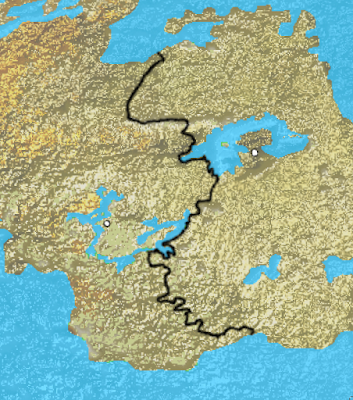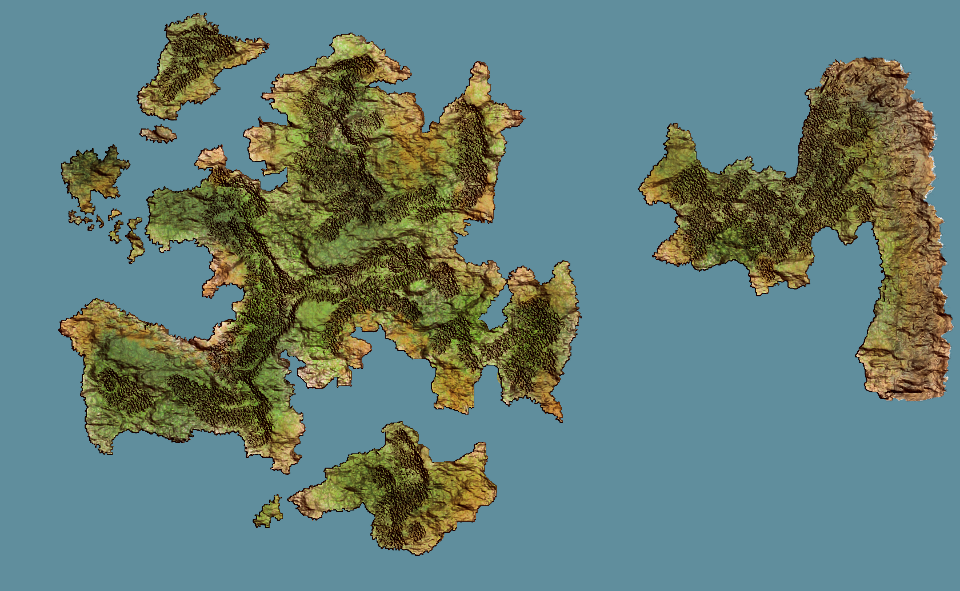Now that I have an Idea of what the landscape looks like, I am about to set a couple of rules.
|
Now that that's established, I head over to the Seventh Sanctum, and hit the fantasy race generator once, and pick what I like. Regularly, one could skip this step, and just assume baseline Human everywhere, but I'd like some variation - also different creatures have different needs and mindsets - which should be reflected in a fantasy-map.
If you're here just for the mapmapking, you might want to skip this.
- The race of gnomes. They are white-skinned and have red eyes. They have a rich culture. They worship a single god who works via assorted servants and messengers. They control an
impoverishedocean kingdom that is the site of a lost civilization. - The race of Ogres. They change genders as they age. They produce great warriors. They avoid all kinds of magic except summoning magic. The god that created them in turn abandoned them.
The misshapen race. They are pale-skinned and have strange ears. They naturally hybernate. They are an all-male race. They control an island chain. A great doom awaits them, and they know it not.If they are all male, I can imagine what doom awaited them.- The race of raccoon-people. They have a rich culture. They practice some forms of spiritual discipline, but some would debate if it is an actual religion. They are intimately connected to an important prophecy.
- The race of evolved mice. In their culture, code-breaking is a highly prized ability. They are exceptionally good at light magic. They existed only as slaves, but most won their freedom in revolt against their masters. Their history is unknown even to them.
- The race of elves. They are yellow-skinned and have red eyes. They have perfect memories. The only kind of magic they can do is air magic. Their gods are said to be dead or have fled this world.
They have no country of their own, but work for other races.since we want nations. - The race of elves. They are orange-haired and have gold eyes. They can change genders under certain conditions. They can see in the dark. They are exceptionally good at flesh magic. They are in general, atheists. They control a desert country. They came from another dimension.
- The gigantic race. They are yellow-armored and have three arms. They interbreed easily with other species. They take naturally to mountain ranges. They are well-known for their postal system and dangerous poisons. They turned their back on their old gods to follow stranger ones. Their government is extremely corrupt.
- The race of Griffin-people. They are genderless, and are able to reproduce on their own. They are well-known for their canals. They were created as part of a breeding experiment that went horribly wrong.
- The race of evolved weasels. Their magical practices tend to focus on divine magic. They are very lazy. They have no defining religion, preferring to pick and choose from the pieces of other religions. They are the descendents of another race.
Now let's place them.
The Genderless Griffin-people have a thing for canals…wouldn't that go really well with a prominent Landmark we have. Depending on how over-the top we want them, they could have built the giant canal… or maybe their ancestors did.
Our evolved mice could live nearby, since they are ex-slaves (someone must have dug those canals) - also they are mice and codebreakers, so they might be heavily into numbers and very sneaky - I'd add some around there, using the canal itself and the red zone as protection against their former masters.
Our gigantic yellow friends also have an Ideal place for them - that mountainous island, I'm sure everybody else would hate.
Now, the ocean kingdom of that white-skinned goblins should be easy to place too. How about here:
The races we have left now have no location descriptions for them, so I assign them to other random criteria.
Flesh magic sounds like something, lots of 'regular' people would find disturbing, conditional gender-changing also doesn't sound regular, and we have no red-zone inhabitants yet, so our Orange-haired 'elves' go in a red zone, preferably further away from already placed settlements.
While we're at placing elves, the more 'regular' yellow ones should go somewhere too. I tend to just say that they are still somehow related, so let's place them closer.
Now, all that we have left are gender-changing Ogres, Raccoons and Weasels, and we still have a whole 'continent' left, so placing them should not be that hard.
I'd make the warrior Ogres red-zone guys too, so we have at least one more of them. therefore, I need to place them here
Which leaves the remaining landmass to our two rodent-species, I'd place them here:
And here:
Now that that's taken care of, let's go to…
The political map
I placed good visible dots where I assigned the 'starting locations' of the different races/factions, and took a big brush with a high falloff and 50% opacity, and clicked on every point a couple of times. What we get is a good picture of where the early (potential) conflict zones are.
Since I placed the first two factions very close together, I drew the border along the obvious lines - borders of red-zones, elevations, coastlines and rivers.
Same goes for our Elves and warrior Ogres -
As for our two rodent-species, they do not manage to keep their respective lakes from each other (allowing for lots of piracy and naval incursions … because adventure-friendly), also they clearly fought for every single hill in previous conflicts.
Now there are two factions that could expand unhindered - at least as long as they hit resistance, creating additional borders for our yellow-giant friends
For our seagoing Gnome-pirates (Arr), I imagined Viking style expansion, combined with no real enemy to concentrate on, I gave them lots of small islands they could probably reach, and quite some colonies at remote and shallow shorelines. - this is what we end up with.
Or even better:
From here it could go either way… I'd find it likely that our sailor-gnomes' outposts would probably be hard to control centralized, and turn into their own little respective kingdoms, our corrupt yellow giants could use their strengths, and easy interbreedability to their advantage, and hire out 'mercenaries' to the other factions, while keeping to their home-landmass. If we would like our Griffon-people to have a bigger empire, the Mouse-kingdom could be pushed back to the atoll in the east, their shared islands could form their own little kingdoms with the other factions instead of fighting them. Also the green-zone elves could severely pushed back by their neighbouring factions.
The sweet part is, that the map does a great deal of storytelling on it's own.





































